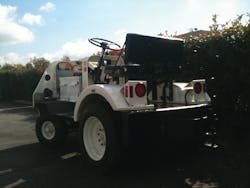New Technology Produces Different Breed Of Electric GSE
You might not think a tugboat would have anything in common with a tug, but a Canadian lithium battery-maker is using lessons learned in marine applications to potentially provide long-lasting power for electric GSE equipment.
Corvus Energy, Richmond, British Columbia, is currently testing a new generation of GSE to run on lithium-ion batteries. Corvus has already developed a Tug Technologies MA series baggage tug retrofit, and is also working on retrofit kits for a 660 belt loader and GT35 pushback retrofit kits for its test project. Corvus also sells a factory-installed kit that allows OEMs to ship a fully electric unit directly to customers.
The company began developing its batteries in 2009 for use in hybridizing heavy commercial vessels such as tugboats. In early 2009 a 78-foot hybrid tugboat named the Carolyn Dorothy was built to work in the port of Long Beach, CA. According to the company, testing on the tugboat showed fuel savings of 25 percent and maintenance bills dropped 30 percent. In addition, third-party testing showed big reductions in carbon emissions
“Electrification of airport GSE is a natural application of our technology due to the heavy workload and long run times associated with commercial airport operations,” says Sean Puchalski, vice president of business development.
The company’s marine heritage is easier to understand considering Corvus got started by a naval architect and another executive who holds more than 70 patents in battery management systems.
Lithium-ion batteries are a common, source of power for most mobile phones or laptop computers.
“Most traditional lithium-ion batteries are cheap, made overseas and use a technology that’s been around for about 20 years old,” says Grant Brown, marketing director.
Most lithium-ion batteries are all built in similar ways. Individual cells are sandwiched together with two electrodes – positive and negative – separated by an electrolyte. Depending on whether the cell is charging or discharging, lithium ions flow back and forth between the electrodes. The generated current flows to an external circuit powered by the battery.
The big difference in Corvus lithium-ion batteries can be found in the makeup of the cell itself. The internal construction of the cells found in the batteries allows for virtually no internal resistance. According to the company, 99.8 percent of electrical energy put into the battery comes back out as usable power – not heat. The lithium polymer construction makes for a completely stable product that is not susceptible to the thermal runaway issues that have plagued the types found in most consumer electronics.
“We don’t have any of the heat issues with traditional lithium-ion batteries because ours have a lower internal resistance,” Brown explains. He adds that they have “done all sorts of torture tests” on the batteries, even shooting them with a high-caliber rifle. “We can’t get them to catch on fire.”
Most competing lithium-ion batteries are made with lithium iron phosphate. Corvus uses a proprietary blend of lithium, nickel, manganese and cobalt. The chemistry behind the blend puts more juice inside the batteries without sacrificing power to weight ratio. And rather than relying on a 20-year-old technology, the Corvus cells are manufactured by Dow Kokam (a subsidiary of Dow Chemical) at a Michigan plant since 2009.
Brown says his lithium-ion batteries contain up to 10 times the power and energy storage of lead-acid batteries and can last 10 times as long. Plus, the batteries can pack that power in half the volume and a quarter of the weight of traditional lead-acid batteries.
“The result is more power in a smaller size,” Brown adds. “Basically, the batteries increase power in terms of horsepower and capacity in terms of how far a vehicle can travel – a bigger gas tank so to speak.”
The company also makes a patented power management system that keeps the utmost control on the charging and discharging rate of the cells. As a result, the company says a module can be charged completely from an empty state in as little as 30 minutes. Their CorPower TM tug retrofits kits are charged with the same chargers used by the automotive industry for electric vehicles and is an off-the-shelf standardized plug, available from a wide variety of manufacturers.
The power management system also helps run diagnostics making easy work of routine checks and trouble-shooting. Each battery has an onboard computer that communicates with other batteries and stores data about usage over its history. This allows a GSE technician the ability to download data via a hard link or wireless transmitter to a computer. The company says maintenance is reduced to tires, brakes and differential oil. The equipment may be used on a near-constant basis with virtually no downtime due to maintenance.
Retrofit kits are priced to be competitive with major rebuilds, and the subsequent savings are compeling.
“We’ve worked out a comprehensive return on investment,” Puchalski says. “Based on actual data from a half-dozen ground handlers at airports of various sizes, what we’ve found is that these kits will pay for themselves in fuel and maintenance savings in just a few years.”
